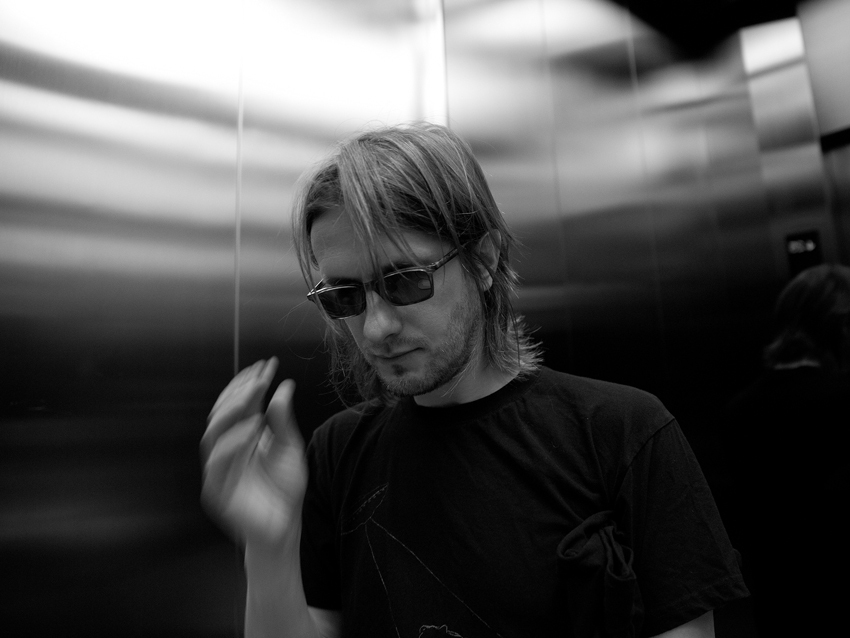
Steven Wilson on recording Hand. Cannot. Erase.
In 2015, Steven Wilson's new album, Hand. Cannot. Erase., is simply The Thing That Shouldn't Be: Eleven tracks clocking in at over 65 minutes, it's the genuine concept record article, built more for sustained, top-to-bottom listening experiences rather than short-bite consumption. Musically, it's a full-course sound-and-genre menu that runs the gamut from epic prog-rock to industrial textures and rhythms to pastoral acoustic pop. So right there it's got that going for it.
But Wilson goes all-out, interweaving the songs into a harrowing story based on the true account of Joyce Carol Vincent, whose corpse was found in her London apartment in 2006, with evidence suggesting that she had died three years earlier. "It's very cinematic, this story," Wilson says, "kind of like a feature film or a novel for the ears. Making an album like this does feel like a willfully indulgent thing to do, but there does seem to be a bunch of people out there who appreciate it. They appreciate the album as an art medium, and they’re happy that there are people like me who do want to tell stories across the long form.”
Wilson worked the same basic core of musicians who played on his previous solo album, 2013's The Raven That Refused To Sing (And Other Stories) – guitarist Guthrie Govan, drummer Marco Minnemann, keyboardist Adam Holzman, bassist Nick Beggs and saxophonist/flutist Theo Travis – but he also added former XTC guitarist Dave Gregory and drum extraordinaire Chad Wackerman to the mix, along with vocal contributions from Ninet Tayeb and Katherine Jenkins. Top that off with the London Session Orchestra and the Cardinal Vaughan Memorial School Choir and you've got the kind of record they just don't make anymore, a dizzying sonic and narrative adventure that seems to grow in scope and meaning with each listen.
Wilson sat down with MusicRadar recently to talk about the origins and the recording of Hand. Cannot. Erase, along with his thoughts on being an album-oriented composer in the age of the single.
People always ask songwriters, ‘What comes first, the words or the music?” But in your case, with this album, in particular, what came first – the story or the music?
“That’s a hard question to answer. It’s not something I’m necessarily aware of. Let’s just say this: I was aware of the background of my character, who is based on a young woman named Joyce Vincent. She was found dead in her apartment in London in the last decade, in 2006, but she had been there undiscovered for three years. I had seen a documentary on her, and so I was aware of her story and was very affected by it, and I carried it around with me for some time.
“When I sat down to write new music, I found that I was writing about a character based on Joyce Vincent. So it wasn’t like I made a very conscious decision, like, ‘OK, I’m going to write an album about this female character.’ I just think that something about her story stayed with me. I wouldn’t be so pretentious to say that the story chose me, but there were elements of that in a way. I don’t consciously make a decision of what I’m going to write about, but of course, once I start writing, certain things do come out.
“The more I wrote and developed this story, the more of a gift it became, because it touched on so many things that I wanted to write about and talk about. There’s the way the internet plays such a big role in our lives – social networking and all that. Then there’s loneliness and living in the city, nostalgia for childhood. All of these things came into the story, so it developed and became this wonderful gift for this record to ultimately hang off.”
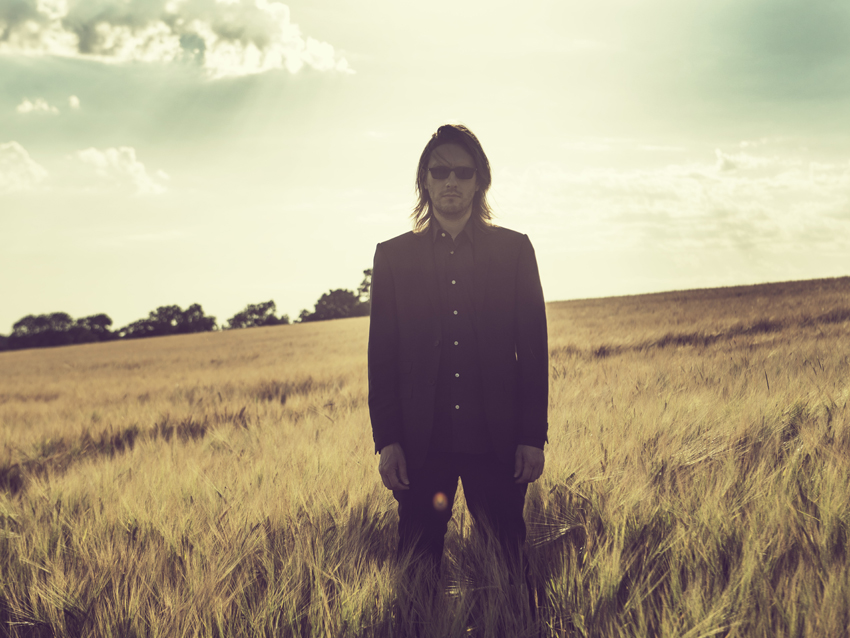
On the album format
This record flies in the face of where the music industry is these days. In very real ways, you really couldn’t do what you do without the long-form album format.
“You know, I don’t think I’d be interested in making music if it weren’t for the album. I guess it would be like saying to a film director, ‘You can never make a feature film again; you can only make three-minute shorts.’ Or saying to a novelist, ‘You can never write a novel; you’re only allowed to write short stories.’ A lot of those guys would say, ‘OK, I don’t want to do it at all then, because this is what I’m about. I like making feature films,’ or ‘I like writing long-form novels.’
“For me, it’s the same thing, really. This is what I do, it’s what I’m interested in doing, and it’s what I’ve spent the last 20 years of my life refining. But it’s tough to take that approach in 2015 because the album is no longer in vogue. The album isn’t experienced like it was in the ‘70s or ‘80s; it’s no longer the way people engage with popular or rock music.”
You used most of the same musicians who played on Raven. Musically, were you looking to continue the dialogue that you established with them on that album?
“I think the short answer is yes. We had a great time during the whole album cycle of The Raven That Refused To Sing. Making the record and touring it, there was a nice connection or empathy, whatever you want to call it. I thought there was more to come out of that kind of a relationship. So while I did want to continue with those guys, yes, conceptually this was going to be a very different kind of record and a very different-sounding record.
“The Raven That Refused To Sing is an album that conceptually was set in the past; it was this idea of almost classical ghost stories. In that sense, it suggested to me something of a vintage, old-school approach in the sound and recording. Next we come to the Hand Cannot Erase project, which is set in the modern age and in the hard heart of the city. Straightaway to me, that suggested to me more of an electronic sound, more processing of the instruments and an almost industrial aesthetic in places.
“But because it’s also the story of someone’s whole life – from birth through childhood and adolescence to growing up and moving to the city – it also suggested a broader musical palette and approach. There are electronic songs, pop songs; there are longer, more progressive-oriented pieces; there are singer-songwriter vibes, metal riffs; there are sound design ambient interludes. There’s everything on this record. So that broader musical palette meant working with different musical forces.”
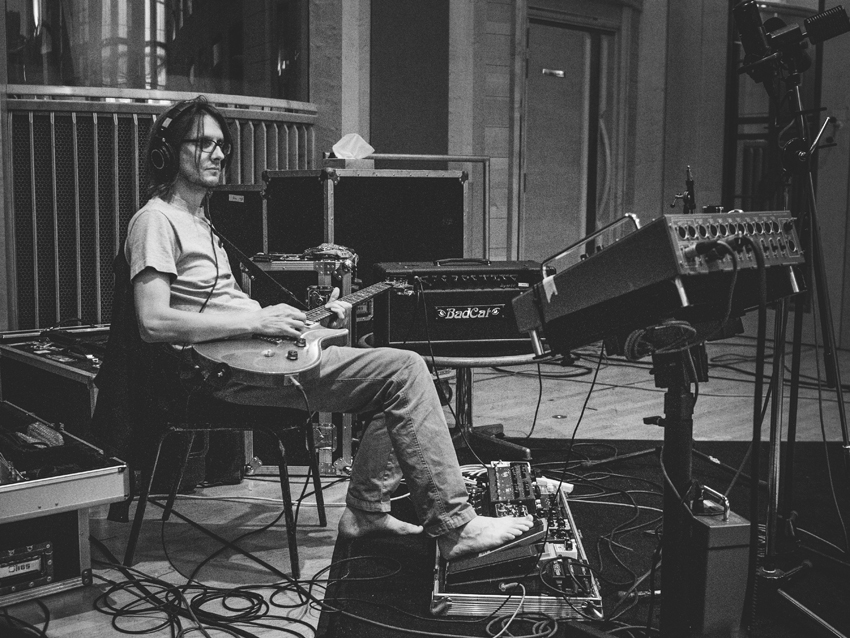
On mixing
When we talked about The Raven album, you described your role with the other musicians as being a “musical conductor.” Would you say the same for this record?
“I was a bit more in the mix on this record. Part of that was because of some of the things I talked about – the use of electronics and more sound design stuff – I’m quite good at those things. I don’t feel like I need to delegate that to anyone else. When it comes to great guitar playing or great keyboard playing, I’ll always delegate that to Guthrie or Adam. Working with weird and wonderful sounds, the sound processing – I’m good in those areas. There’s a lot of that on this album.
“When you listen to The Raven, you’re pretty much listening to six musicians playing live together. That’s not something I can say about this album. There are moments of people playing together, but overall it’s more of a studio construct.”
You’re quite the skilled mixer and remixer. No thought to having somebody else mix the album?
“No, no, I’m afraid I’m way too old and set in my ways to let anybody else mix my music. I have to be in control of that aspect, most definitely. I had a great engineer for the studio recording of the album – Steve Orchard, who is Paul McCartney’s regular engineer. He’s no slouch; he’s a guy who really knows what he’s doing. I’m lucky to have a guy like him on the sessions because it allows me to worry about working with the musicians; I don’t have to worry about microphone placements or any of that stuff. I’ve been very lucky to work with people like Steve and Alan Parsons – Alan engineered the last record.”
First Regret/ 3 Years Older is almost 13 minutes long. Did you do a full demo of it, and did you follow it fully when doing the studio version?
“I would have to play you the demo to really answer that. It’s not really one or the other. The structure and all the parts are defined and kind of stay set in stone once the demo’s complete, but there were so many things in the final recording that were ideas we explored in the studio.
“Solos are interesting – you’re always listening to the musical voice of the particular player. I don’t write the solos. With Adam and Guthrie, the keyboard and guitar solos are always improvised. Solos are a big part of this record – some of them go on for two or three minutes. They’re very essential to the whole thing. There were some other things – flourishes and guitar parts, keyboard parts – that weren’t on the demo. The important thing is, when I walk into the studio with these musicians, we’re not wasting time trying to arrange or structure the pieces.
“As you pointed out, this is about a 13-minute stretch of music. There are many ways to put something like that together. I spent a year, before we walked into the studio, experimenting with the structure and arrangements of those tracks. So it’s a bit of both, to answer the question.”
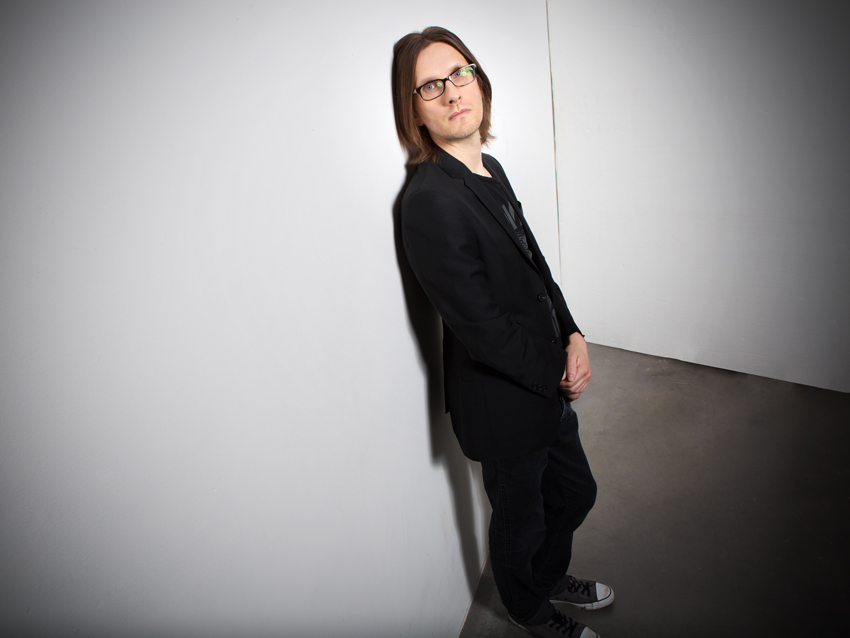
Story and music
How did you go about choosing Ninet Tayeb and Katherine Jenkins to be guest vocalists?
“As much as it was a challenge for me to write from the perspective of a female character, I wanted to legitimize that fact by having a female presence on the record, and that came from Katherine, the voice actress, and Ninet, who sings; in fact, on Routine, she sings quite a bit of the lead part. I discovered early on with that song that I wanted it to be a three-way vocal thing: I wanted my voice, I wanted the female singer, and I wanted the voice of the choirboy. It was quite ambitious.
“For the female vocal, I wanted somebody with an extraordinary voice, but I didn’t want the regular kind of R&B-style voice; I guess I was looking for my Kate Bush or Bjork, someone a little quirky, with a bit more personality, but someone who could really soar when needed. I asked around to my friends, and Aviv Geffen, my partner in the Blackfield project, recommended Ninet, who is an Arab-Israeli. She was one of three or four girls who did demos of Routine for me, and hers just blew me away. Shivers up the spine and all that.”
There’s some brilliant soloing on the record, but one of my favorite bits is the arpeggiated rhythm guitar work on Happy Returns. It’s very elegant, restrained, shimmering and just beautiful.
“That’s Dave Gregory from XTC. He played some beautiful stuff on three of the songs. I think he used an old Rickenbacker for that. It’s got that lovely kind of crystalline ‘60s vibe to it, the part you mean.”
Did you record to analog?
“That depends on what you mean by ‘analog.’ Everything on the record, with a few exceptions – there are some electronic things that were done with plugins – was sourced from analog. For example, the keyboards are real piano, real Fender Rhodes, real Mellotron, real Hammond organ going through real analog preamps and compressors, but right at the end of the process everything is recorded into digital at very high resolution – 96/24. At that point, it stays in digital right through the mixing process. For me, that’s the best of both worlds, because I love the sound of analog but I love the mixing capabilities that digital brings me.”
Because the album follows a story, does that dictate how you sequence the songs? Or do you link the songs so that they flow together the best musically?
“That’s a very good question. The most difficult thing to get right on a record like this is to get the music and story to work in sympathy with each other. Once you get a story, you have a set narrative, and it’s not easy to move songs around just because you think it sounds musically better. It’s like taking chapter five from a book and moving it to chapter one – suddenly, things make no sense."

Influences
“It’s quite a juggling act to find the right way to have all the music unfold as a satisfying journey while the story still works the way it’s supposed to. All I’ll say is, it took a long time and it was quite frustrating. I had to take bits out that didn’t make sense with the story or the other music; there were other lyrics I had to take out, too. Quite frustrating. It’s probably the same kind of problem that screenwriters grapple with all the time. It’s an unusual problem to have. I’ve done themed records before, but I’ve never done one that went from point A to point B in terms of telling a story.”
What song put up the biggest battle? Was there one that you had to wrestle to the ground a little bit?
“Oh, yeah – 3 Years Older. Finding the right structure for that one was a nightmare. That 10-minute piece of music has got so many sections to it, so the trick is to make it flow and not feel like it’s 10 minutes – the whole song, really. I think the reason why it works in that way is that each part unfolds very organically; each bit moves naturally from the previous idea. It’s something that sounds easy, but it’s really, really hard. [Laughs] An extra bar here and an extra bar there, one too many ideas here and one too many ideas there – suddenly, the whole thing doesn’t gel.
“That song is one of the first I started to write. There’s the riff, what I call the ‘Townshend riff,’ and everything grew from there. But it was probably a year of juggling parts and moving sections, dropping parts, rewriting bridges and writing new lyrics before it all fell into place. You used the word ‘battle’ – that song was a bit of a battle.”
For that song, I wrote down in my notes, “Perfect combination of Houses Of The Holy and Yes’ Fragile.”
“Oh, really? That’s cool. I haven’t heard those comparisons before. People find reference points that you weren’t even aware of, but they’re there. Like the Townshend thing for me is very conscious; I was definitely tapping into his approach to playing the guitar. Sometimes people mention a reference that I hadn’t thought of, but then I listen back and I see what they mean. It’s kind of fun in a way. There are things in my musical DNA that are so deep rooted that they come out without my even thinking about them.”
In addition to the Townshend riff, were there any moments that were inspired by conscious references?
“Yeah, sure. A song like Perfect Life, which is a very electronic, that was inspired by the Boards Of Canada – they’re a duo from Scotland. There are lots of Kate Bush, too, moments because I was listening to her music a lot at the time. Those are the ones that come to mind, but I’m sure, like what you mentioned, that there are some that were unconscious. I love hearing the things people pick out.”
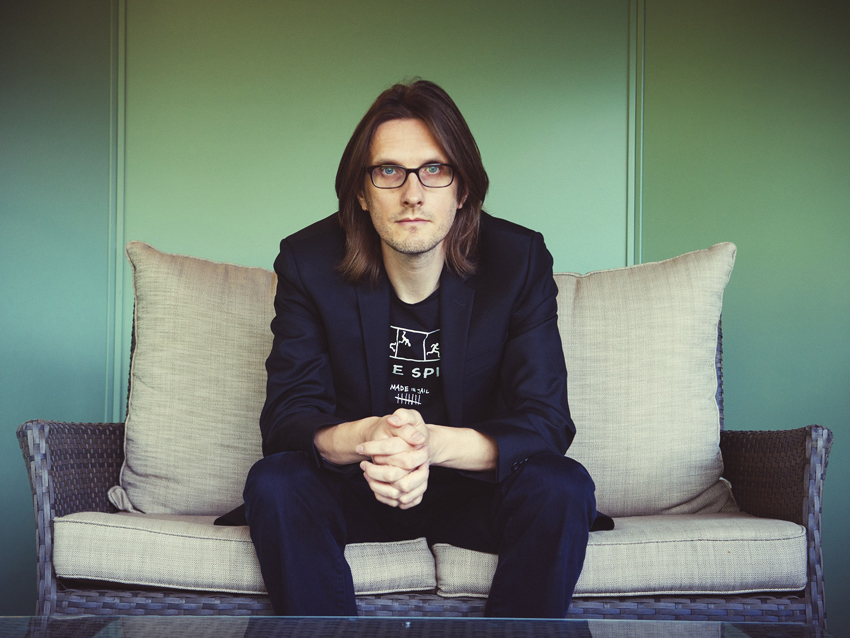
The touring band
It’s interesting when some musicians say they’re not influenced by anybody. I don’t really believe them.
“Well, I can understand why they say that. There are a lot of musicians nowadays who make music in a kind of vacuum and they don’t listen to any other music. I know a lot of guys who make records now, and they’re actually not interested in music anymore. But the point is, they were at one time; at a certain point in their life, they were voracious listeners of music and had a huge appetite for it. Those things become part of your DNA and your musical personality.
“No one starts out making music in a void. Everyone is inspired to pick up an instrument or to become a writer because of something and somebody. Those things are always there, and you can’t make music without those influences. It’s just not possible.”
What kind of band will you tour with behind the new album?
“I’m starting in Europe with Guthrie, Adam on keyboards, Marco on drums, Nick on bass and myself sort of darting around between things. By the time we get to America, I’m going to have to change slightly because Guthrie and Marco will be doing their own thing with The Aristocrats.”
Those Aristocrats guys aren’t too shabby.
“No, they’re not. [Laughs] It’s just too bad they have The Aristocrats – for me, I mean, not for them. But I’ve known about this for a while, so it’s not a nasty shock. Guthrie will be replaced by a guy named Dave Kilminster, who’s been playing with Roger Waters for the last eight years; that was actually Guthrie’s recommendation. And I’ve got a great British drummer named Craig Blundell who’s coming in to replace Marco.
“A little bit of a lineup change before we come to America, but the bottom line is, they're all world-class musicians. I’m very fortunate these days to be working with players of that caliber.”
Steven Wilson's Hand. Cannot. Erase. will be released February 27 in Germany, March 2 in the UK, and March 3 in the US and Canada. You can pre-order the album at Amazon and iTunes.
Joe is a freelance journalist who has, over the past few decades, interviewed hundreds of guitarists for Guitar World, Guitar Player, MusicRadar and Classic Rock. He is also a former editor of Guitar World, contributing writer for Guitar Aficionado and VP of A&R for Island Records. He’s an enthusiastic guitarist, but he’s nowhere near the likes of the people he interviews. Surprisingly, his skills are more suited to the drums. If you need a drummer for your Beatles tribute band, look him up.
